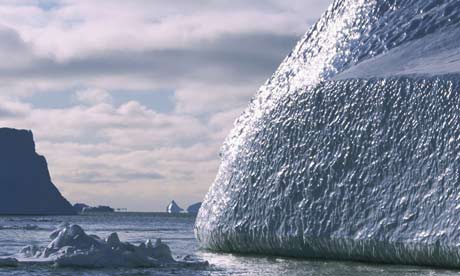· Meltwater plays only small role in glacier flow
· Study casts doubt on 'lubrication' theory
- The Guardian,
- Friday April 18 2008

Greenland’s summer lakes, which can drain away as fast as Niagara Falls, do not seem to contribute towards rising sea levels. Photograph: David McLain/Getty Images/Aurora
Fears that the rapid draining of water from the top of Greenland's ice sheet may be contributing to the rise of global sea levels have been allayed by new research. Though scientists confirmed that the water can drain away faster than Niagara Falls, it did not seem to accelerate the movement of the ice sheet into the ocean as previously thought.
Receding ice sheets are of major concern to climate scientists because the melting water could lead to a rise in sea levels. In addition, the melting can encourage feedback mechanisms that amplify the warming effects of greenhouse gases in the atmosphere: ice and snow reflect sunlight, so less of them means more heat is absorbed by the Earth. Observations have already shown that the speed at which glaciers at the edge of Greenland are moving into the sea has doubled in the past two decades.
Thousands of lakes form on top of Greenland's glaciers every summer due to the increased sunlight and warmer air. Satellite observations have shown that these lakes often disappear, often in as little as a day, but no one knew where the water was going or how quickly it moved.
When these lakes were first discovered in recent years, experts became concerned that the melting water might make its way to the base of the ice and lubricate the Greenland ice sheet's passage into the sea, which would contribute to a global sea-level rise. In a warming world, more lakes are expected to form on Greenland, raising the possibility that the entire ice sheet will melt more quickly than expected.
But the new research, published today in Science, has cast doubt on that theory.
Sarah Das, of the Woods Hole Oceanographic Institution in Massachusetts, led a study that monitored the evolution of two surface lakes on Greenland in the summers of 2006 and 2007. Using aerial surveys and satellite imagery, they monitored the lakes and tracked the progress of glaciers moving toward the coast.
She said the most impressive drainage event occurred in July 2006, when most of a 5.6 sq km lake holding 11.6bn gallons of water emptied in just 90 minutes. The scientists estimated the average flow rate to be more than that of Niagara Falls. Underneath the lake, the ice sheet was raised and began moving horizontally at twice the average daily rate.
But her team also found that, when considered over the whole year, the surface meltwater was responsible for only a few per cent of the movement of the glaciers that they monitored. Even at its peak, it appeared to contribute only 15%, and often less, to the annual movement of the outlet glaciers at the edge of Greenland.
"Considered together, the new findings indicate that while surface melt plays a substantial role in ice sheet dynamics, it may not produce large instabilities leading to sea level rise," says Ian Joughin, a glaciologist at the University of Washington. "There are still other mechanisms that are contributing to the current ice loss and likely will increase this loss as climate warms."
"To influence flow, you have to change the conditions underneath the ice sheet, because what's going on beneath the ice dictates how quickly the ice is flowing," said Das. "If the ice sheet is frozen to the bedrock or has very little water available, then it will flow much more slowly than if it has a lubricating and pressurised layer of water underneath to reduce friction ... It's hard to envision how a trickle or a pool of meltwater from the surface could cut through thick, cold ice all the way to the bed. For that reason, there has been a debate in the scientific community as to whether such processes could exist, even though some theoretical work has hypothesised this for decades."
Glacial ice is second only to the oceans as the largest reservoir of water on the planet, and 10% of the Earth's glacial ice is found in Greenland. The west Antarctic ice sheet is also increasing the rate at which it is losing mass. In a recent interview with the Guardian, leading Nasa climate scientist Jim Hansen said the ice sheets' increased shrinking meant that the world's targets for reduction of carbon emissions were not stringent enough. "If we follow business as usual I can't see how west Antarctica could survive a century," he said.
Hansen said recently that the EU target of 550 parts per million of C02, already the most stringent in the world, should be cut to 350ppm if "humanity wishes to preserve a planet similar to that on which civilisation developed".

No comments:
Post a Comment